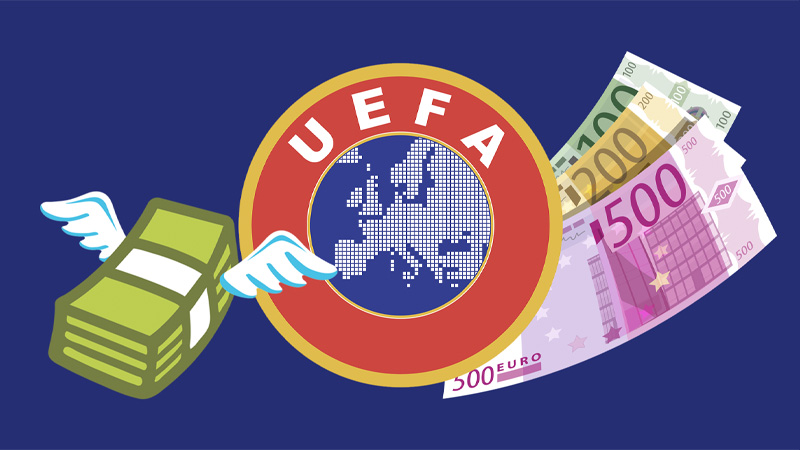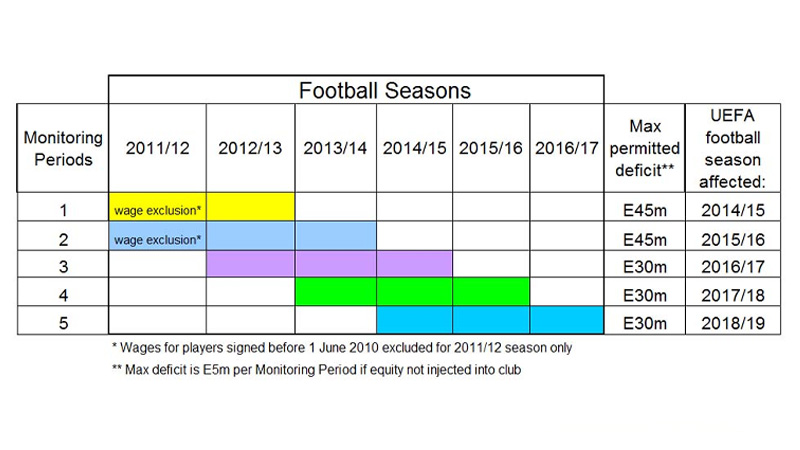Financial Fair Play (FFP) rules, instituted by UEFA in 2011, have become a cornerstone of European football governance. These regulations were designed to promote financial sustainability and create a fair and competitive landscape for clubs.
Under the FFP framework, clubs are required to balance their books, ensuring that expenses do not exceed revenue generated, thus curbing excessive spending and debt accumulation.
By imposing strict financial constraints, FFP aims to level the playing field, preventing wealthy clubs from dominating the transfer market and enhancing the competitiveness of the sport.
Additionally, FFP encourages clubs to invest in youth development and community projects, fostering long-term stability.
However, the rules have not been without controversy. Critics argue that FFP stifles ambitious clubs’ growth and may exacerbate existing disparities.
Nevertheless, over the years, FFP has transformed football’s financial landscape, molding a more sustainable and equitable future for the beautiful game.
Financial Fair Play (FFP) Rules in Football
The concept of Financial Fair Play emerged in the early 2000s as a response to the escalating financial troubles faced by many football clubs. The vast financial disparities between wealthy and less affluent clubs threatened the integrity and competitiveness of the sport.
UEFA introduced the FFP regulations in 2011 as an attempt to address these issues and safeguard the long-term sustainability of football.
Principles and Objectives of FFP
The core principles of Financial Fair Play revolve around four key objectives:
- Encouraging Financial Stability: FFP aims to foster financial stability by promoting responsible financial management and preventing clubs from accumulating excessive debts.
- Improving Transparency: Clubs are required to disclose their financial information regularly, enhancing transparency and accountability within the sport.
- Limiting Excessive Spending: FFP sets limits on the amount clubs can spend on players’ wages and transfer fees in relation to their revenue, preventing clubs from engaging in reckless spending.
- Promoting Youth Development: FFP encourages clubs to invest in youth development programs, nurturing homegrown talent rather than relying solely on expensive transfers.
Key FFP Regulations
- Break-even Requirement: Clubs are required to balance their financial books over a set accounting period. They must not incur losses exceeding a certain threshold as defined by the FFP rules.
- Club Licensing: As part of the licensing process, clubs must provide financial records and demonstrate their compliance with FFP rules to be eligible for UEFA club competitions.
- Monitoring and Sanctions: UEFA monitors clubs’ finances regularly to assess their adherence to FFP regulations. Failure to comply may result in various sanctions, such as fines, transfer bans, or exclusion from UEFA competitions.
Criticisms and Challenges
While FFP aimed to level the playing field and improve financial discipline, it has faced criticism and challenges:
- Unequal Impact: Some argue that FFP disproportionately affects smaller clubs, limiting their ability to compete with wealthier counterparts.
- Creative Accounting: Clubs have been accused of exploiting loopholes and employing creative accounting practices to bypass FFP rules.
- Competitive Imbalance: Despite FFP, financial disparities remain significant, and some clubs continue to spend lavishly on players, creating a competitive imbalance.
The Future of Financial Fair Play
Over the years, FFP has undergone revisions and adaptations to address its shortcomings. The future of Financial Fair Play lies in finding a balance between promoting financial stability and fostering a competitive and diverse football landscape.
What Are the Limits for Financial Fair Play Premier League?

Source: goal
As of my last knowledge update in September 2021, the Financial Fair Play (FFP) regulations in the Premier League were known as the Profit and Sustainability (P&S) rules.
The Premier League’s Profit and Sustainability rules govern how much financial losses a club is allowed to incur over a specific period and aim to promote financial stability and responsible spending within the league.
The specific limits and thresholds for the Profit and Sustainability rules may change from season to season as the league regularly reviews and updates its regulations.
However, some key points to understand about the Premier League’s Profit and Sustainability rules include:
Loss Threshold
Premier League clubs are allowed to incur a certain amount of financial losses over a three-year monitoring period. The limit on allowable losses aims to ensure that clubs do not overspend beyond their sustainable means.
Owner Investment
Clubs are permitted to receive financial injections from their owners to cover operating losses or invest in infrastructure and youth development. However, there are limits on how much a club can receive from its owners without it being considered a breach of the P&S rules.
Additional Revenues
The Premier League allows clubs to generate additional revenues through commercial deals, broadcasting rights, and other means. These additional revenues can be used to offset losses and contribute to the financial stability of the club.
Sanctions
If a club fails to comply with the Profit and Sustainability rules, it may face various sanctions. These sanctions can range from fines to transfer bans or even points deductions, depending on the severity of the breach.
Long-term Sustainability
The primary objective of the Profit and Sustainability rules is to ensure that Premier League clubs operate within their financial means and maintain long-term sustainability. By promoting responsible financial management, the league aims to protect the competitive balance and integrity of the competition.
How Is Financial Fair Play Calculated?

Source: financialfairplay
Financial Fair Play (FFP) is calculated based on a set of financial indicators and thresholds that aim to promote financial stability and sustainability among football clubs.
While the specific calculations may vary slightly depending on the governing body or league, the fundamental principles of FFP calculations remain consistent. Here’s an overview of how Financial Fair Play is typically calculated:
Financial Period
FFP calculations are usually based on a specified financial period, typically covering three consecutive seasons. This period is known as the “monitoring period.” The monitoring period is used to assess a club’s financial performance and adherence to FFP regulations.
Revenues:
The primary financial indicator for FFP calculations is the club’s total revenues over the monitoring period. Revenues include income from matchday ticket sales, broadcasting rights, commercial deals, and other sources of income related to football activities.
Allowable Losses
FFP regulations set limits on the financial losses a club is allowed to incur over the monitoring period. The allowable losses threshold aims to prevent clubs from spending beyond their sustainable means and accumulating excessive debt.
Owner Investment
FFP rules allow clubs to receive financial injections from their owners to cover operating losses or invest in infrastructure and youth development. However, there are limits on how much a club can receive from its owners without it being considered a breach of FFP regulations.
Calculation of Break-Even Result
The break-even result is a key component of FFP calculations. It is the difference between a club’s total allowable expenses and its total allowable revenues over the monitoring period. The break-even result represents the financial balance that a club needs to achieve to comply with FFP regulations.
Exclusions and Adjustments
Certain expenses and revenues may be excluded or adjusted in FFP calculations to account for specific circumstances. For example, expenses related to youth development or stadium improvements may be excluded from the break-even calculation.
Sanctions
If a club’s break-even result exceeds the allowable losses threshold, it may face sanctions as a consequence of non-compliance with FFP regulations. Sanctions can include fines, transfer bans, or other disciplinary measures.
It’s important to note that FFP calculations can be complex and may involve additional considerations based on specific league or governing body rules.
Additionally, FFP regulations can evolve over time, and clubs and governing bodies regularly review and update their financial policies to adapt to changing circumstances and ensure the continued financial stability of football clubs.
What Are the Sanctions for FFP?
The sanctions for Financial Fair Play (FFP) violations can vary in severity depending on the extent of the breach and the governing body overseeing the competition.
The specific sanctions may differ slightly between different football governing bodies, such as UEFA for European competitions and individual national football associations for domestic leagues. However, some common sanctions for FFP violations include:
Fines
Clubs found in breach of FFP regulations may be subject to monetary fines. The amount of the fine can vary based on the severity of the violation and the governing body’s discretion.
Transfer Bans
One of the most significant sanctions for FFP violations is a ban on participating in transfer activities. This can include restrictions on signing new players during a specific transfer window or multiple transfer windows.
Squad Size Restrictions
Clubs may face limitations on the number of players they can register for domestic or international competitions as a result of FFP breaches.
Exclusion from Competitions
In more severe cases, clubs may be excluded from participating in certain competitions. This could range from exclusion from specific domestic cup competitions to being banned from participating in continental club competitions.
Points Deduction
Some governing bodies may impose points deductions as a penalty for FFP violations. Points deductions can significantly impact a club’s league standing and potential for qualifying for other competitions.
Probationary Measures
Clubs found in breach of FFP regulations may be placed under probation, during which they are closely monitored to ensure compliance with the rules in subsequent monitoring periods.
FAQs
Which football competitions are governed by Financial Fair Play rules?
Financial Fair Play rules were initially introduced by UEFA and primarily apply to clubs participating in UEFA club competitions, including the UEFA Champions League and the UEFA Europa League.
How do clubs demonstrate compliance with Financial Fair Play rules?
Clubs seeking to participate in UEFA competitions must undergo a Club Licensing process. As part of this process, clubs are required to submit financial records and demonstrate their adherence to the Financial Fair Play regulations
What are the potential sanctions for non-compliance with FFP rules?
Sanctions can include fines, transfer bans, restrictions on squad size for UEFA competitions, or even exclusion from UEFA competitions.
Can clubs invest in youth development without violating FFP rules?
Yes, Financial Fair Play rules encourage clubs to invest in youth development programs to nurture homegrown talent.
How have FFP rules impacted football transfers and player wages?
Financial Fair Play rules have led to increased scrutiny of player transfer fees and wages. Clubs are now more cautious about their spending, and some have had to be strategic in balancing their squads to comply with FFP regulations.
Final Words
Financial Fair Play (FFP) rules in football represent a significant step towards ensuring long-term financial stability and sustainability in football.
By promoting responsible financial management and transparency, FFP aims to safeguard the essence of the sport and preserve its competitiveness.
While challenges persist, the continuous evolution of FFP signifies a commitment to creating a level playing field where clubs can thrive based on their abilities, rather than their financial resources.
As football continues to evolve, Financial Fair Play remains a critical component in shaping the future of the beautiful game.







